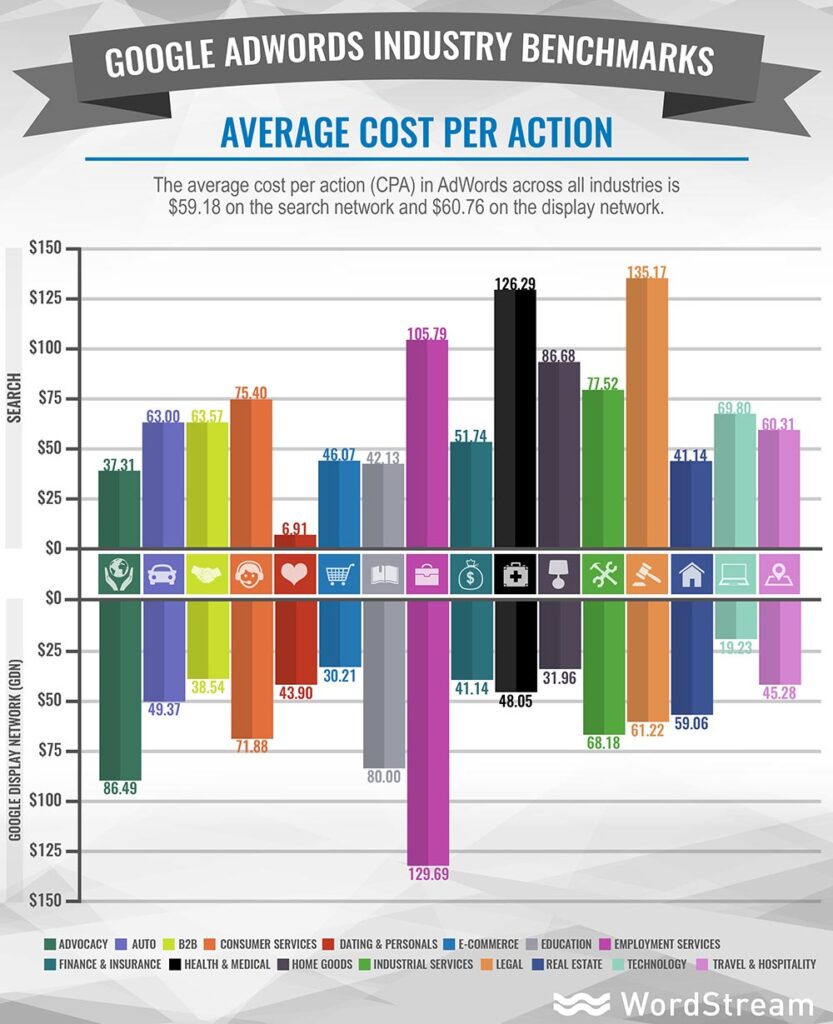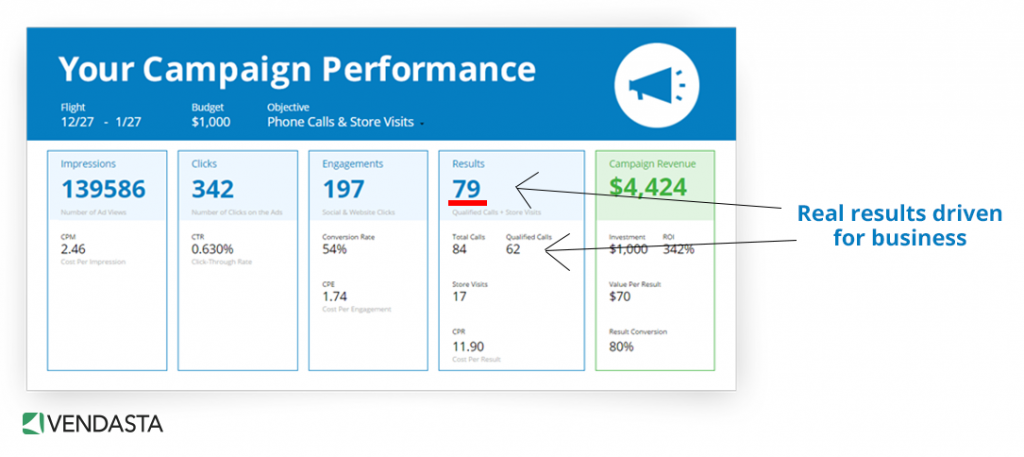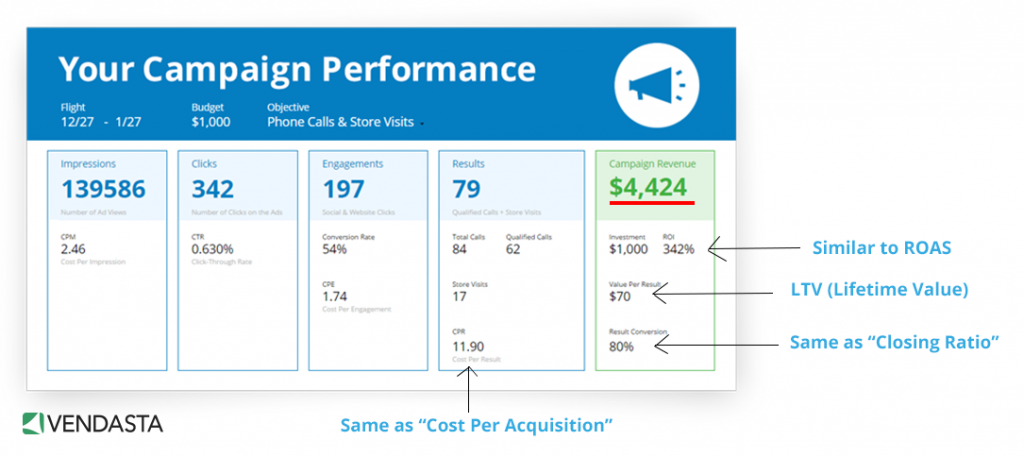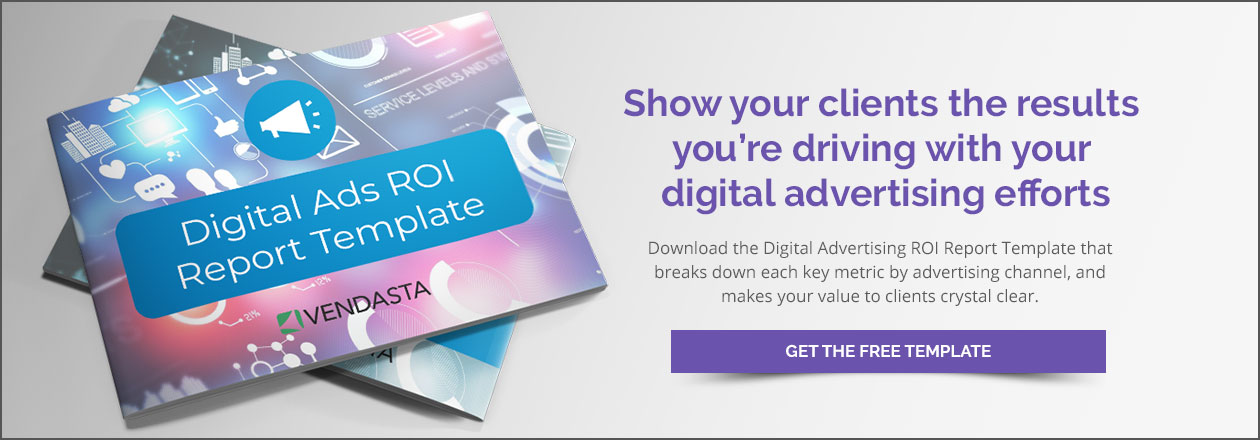Ad ROI Analysis: Choosing Digital Advertising Metrics that Matter
You’ve worked hard on launching that great marketing campaign.
Now, you’re ready to measure the results.
Metrics are your ally.
You can’t do your job well without them. And your clients can’t measure how good you are at your job without that data.
In this wonderful digital era, we’re not short on metrics. CPA, LTV, CR, ROAS, the list goes on.
But how do you know which ones matter and why? How do you perform a proper ad ROI analysis? How can you tell if your ads are successful? How do you communicate results to clients in your monthly reports?
These are all legitimate questions even among seasoned marketers.
While the metrics you choose will depend on your business goals, we’ve narrowed them down to the ones we use regularly to measure our return on investment, or ad ROI metrics.
Use this guide to gain a better understanding of each metric that matters, the ones to avoid, and how to set realistic goals for your next ad campaigns.
Are you a digital agency? Vendasta offers white-label digital solutions for companies that sell to local businesses. Contact us today to learn about how to resell our apps and services under your brand.
Ad Analysis: Which Digital Advertising Metrics Matter?
Choosing the right digital advertising metrics to track and measure is crucial to your campaign’s success. If you aren’t tracking advertising efforts correctly through marketing automation software and tools, you’ll never know what’s working, and you won’t be able to communicate success to your clients.
The first step to determining your ad’s success is setting goals with benchmarks that matter.
Determining your core ROI goals means you’ll be able to measure data that tells the story of how your target audience interacted with your ads.
Here are a few of the key metrics to track that will help you measure success and determine advertising ROI with your Ad Analysis:
CPA – Cost Per Acquisition
How much does it cost you to acquire a new lead in any given channel?
Knowing the cost to acquire a client in your business is the basis of your marketing budget, so it’s crucial data to add to your ROI analysis. Combined with other ad data, this will determine whether your business will make a profit.
Ideally, you’ll want to get a sense for which mix of ad channels (Search, Facebook, Display) work best for your clients in the industries you focus on. Then you’ll be able to better optimize your ad budget going forward.
Joe Castro, Search Engine Marketing Manager for Elevation Advertising, told me that it all starts with leads:
"Lead submissions are important to ROI because your client can track lead submissions throughout the buyers’ journey (hopefully through their CRM). They will then be able to see which channels are driving the most leads and which ones are driving the most quality leads (and therefore ROI). As more leads are generated and your client better understands customer lifetime value, the average sales cycle, etc., then you’ll be able to better allocate budget based on their ROI."
Here’s the formula for CPA:

ROI Analysis Digital Advertising
CPA is a simple but valuable formula. Knowing how much it costs to acquire a new lead is key to understanding your ad ROI as a metric.
How to Analyze the CPA of Your Ad Campaign: This depends a lot on the industry, location, ad type, season, etc. Determining this number for your clients may take some time as your campaigns accumulate data.
SAAS Marketing Consultant Sid Bharath explains:
I've helped clients like Olark and Thinkific to optimize their ads and, regardless of what platform you use, it's a math problem.
Ultimately, the cost of acquiring a customer should be less than your average LTV, preferably 1/3rd of it. Your cost is the product of the cost per click ($X), the conversion rate from click to free trial (Y%), and the conversion rate from free trial to paid customer (Z%). So, to analyze your ad performance, you need to be looking at those three digital advertising metrics - X, Y, and Z. These are the universal indicators across any ad platform.
You’ll also get a better idea as you run campaigns for other clients in the same industry. Wordstream has a useful graphic that compares AdWords (the link also includes Facebook ad CPA averages) CPA averages in several industries:

adwords-industry-benchmarks-average-cpa
However, we still don’t know the actual value of your client’s customers. The next thing we'll discuss is LTV, which is essential for further ROI analysis.
LTV - Lifetime Value
Do you know the lifetime value of your client’s customers? You should!
Why? Well, you’re not necessarily going to have access to your client’s balance sheet, but they should be able to give you a number that represents an approximation of the revenue a new customer brings in, with all associated costs factored in.
If you know your client’s LTV, you’ll be able to compare it directly to the cost of acquiring a new client through your digital ad campaign.
“This is the sum of all transactions, or the total value a customer will spend over their lifetime,” states Baruch Labunski, co-founder of RankSecure. “It is important to know so you can determine how much you can afford to spend to acquire them, and also retain them over time. If this number is high that can help justify increasing your marketing investments, knowing you’ll get the returns over time.”
Getting your clients to simply provide their customer LTV can be a challenge. Many just don’t know!
Here’s the formula you can use to help them get the answer you need. Our digital ads team always asks for LTV because it’s so essential for providing advertising ROI calculations.

How to Analyze the LTV of Your Ad Campaign: If you’re just starting out, you’re not going to know this data for a while. However, it’s something that you should start tracking immediately! Start by using your client’s customer LTV. This is your new benchmark, and attracting customers with a higher LTV from your ads is the goal.
As your campaign progresses, check in with your client to be sure they’re tracking specific campaign LTV based on the quality of the leads your digital ads are bringing in.
Pro Tip: Alex Andrade-Walz, a Growth Marketer at Spatially notes that if you’re having trouble tracking attribution, looking at "session duration" in Google Analytics can be a good proxy for lead quality:
“By breaking session duration down by source and medium, you can see how your marketing channels compare. If, for example, you see that traffic from LinkedIn spends an average of three minutes on your site, while traffic from Facebook only spends half a minute, you can infer that your LinkedIn targeting is bringing in higher quality leads that are more interested in your product or service. At this point, traditional metrics like click-through rate and reach are all moot if the traffic isn't sticking around.”
CR - Campaign Revenue
Now that we understand how to calculate and analyze the lifetime value of your client’s customers, we’ll be able to track the revenue generated by your digital advertising campaign. As you can see below, you just need to multiply your campaign’s conversions by LTV and closing ratio (50% would be .5).
Why include closing ratio? Obviously, every new lead you generate isn’t going to become a customer, so you’ll need to factor in how often your client is able to close new leads to estimate campaign revenue correctly.

How to Analyze the Revenue of Your Ad Campaign: As you perform your ROI analysis, it’s basically impossible to tell you what optimal revenue is per campaign. It totally depends on your goals, the campaign type, and the budget. A decent rule of thumb is a 5 to 1 revenue to cost ratio.
Chris Leone notes that,
“A 5:1 ratio is middle of the bell curve....A 2:1 revenue to marketing cost ratio wouldn’t be profitable for many businesses, as the cost to produce or acquire the item being sold (also known as cost-of-goods-sold, or COGS) is about 50% of the sale price. For these businesses, if you spend $100 in marketing to generate $200 in sales, and it costs $100 to make the product being sold, you are breaking even. If all you accomplish with your marketing is break even, you might as well not do it.”
ROAS – Return on Advertising Spend
ROAS is an illuminating digital advertising metric to use for ad campaigns, and a lot of marketers use it interchangeably with ROI itself. However, there are significant differences between the two. What is the difference between ROI and ROAS?
Tim Mayer, CMO of Trueffect explains:
“ROI measures the profit generated by ads relative to the cost of those ads. It’s a business-centric metric that is most effective at measuring how ads contribute to an organization’s bottom line. In contrast, ROAS measures gross revenue generated for every dollar spent on advertising. It is an advertiser-centric metric that gauges the effectiveness of online advertising campaigns.”
So advertising ROAS is much more focused on the results from specific campaigns, while ROI incorporates the bigger picture relative to the business. This means that it’s much easier for agencies like yours to be tracking and analyzing advertising efforts with ROAS. You know the cost and you can calculate the revenue.

How to Analyze the ROAS of Your Ad Campaign: The answer here is similar to revenue...it depends on a lot of campaign and industry factors. Most of the big digital ad brands would be VERY touchy if you asked them for their average ROAS per industry! However, at least a 5:1 ratio is a good place to start.
Setting your own benchmarks and campaign goals based on past performance is the best way to proceed and prep client expectations.
Digital Advertising Metrics to Avoid
While it’s tempting to pump up other results you’ve accumulated during your client's ad campaign, it’s important to resist this desire!
Justin Adelson, founder of Perfect Pixel Marketing, notes:
“One thing I would NOT do is try to push vanity metrics as a way to mask poor performance. Metrics like clicks, shares, and engagements are fun to look at, but unless they are driving primary conversions (i.e. leads) they are not valuable to their sales funnel.”
This isn’t to say you should ignore this data, but you shouldn’t base campaign goals around them. Think of things like impressions, shares, clicks, and engagements as clues that help you analyze the health of your campaigns. They’re valuable to track and understand, but they shouldn’t take the focus away from the core digital advertising metrics that can make or break your campaigns.
How to Translate ROI Analysis Results
Ensuring that your clients understand what’s happening in their campaigns is super important.
If things are going well, you need to be able to communicate what’s working, and why the campaign is so awesome! If the campaign is struggling, you need to be able to analyze it to know why and explain your plan to turn things around.
Oftentimes, a small business owner isn't an advertising expert, which is why they hired you in the first place. A very important part of the reporting process for them then is to communicate in real-life business results that your digital advertising is driving. Just keep in mind that they are not going to understand all of these advertising ROI metrics.
So what does that mean exactly?
Check your digital advertising jargon at the door! Remember that many local business owners don’t speak the language of digital marketers and might not understand LTV, CPC, ROAS, and all the other acronyms us marketers use to communicate results.
Analyzing your ads and translating your results into relevant digital advertising data is a critical way to help your client understand what you're doing for them. Numbers like in-store visits and phone calls help prove the value of digital advertising to clients.
Try incorporating more universally-understandable local business terms like in-store visits, direct phone calls, and real-life sales to drive home the genuine value of digital advertising.
Let’s dive in a bit more into ways to communicate with your clients to know what to expect from your digital ads campaigns.
Setting Ad Campaign Goals
Businesses have all sorts of different goals for ad campaigns. For example, one business may want to increase phone calls, while another might want to improve their brand’s reputation.
Scott M Warren, owner of Exfil Project, elaborates
“From a lead generation perspective, we also have clients where our primary goal is to drive leads into a sales funnel. This is most often to cold audiences just trying to get name and email addresses to add to the client’s email list. The client creates a relationship with their leads and sales happen later on, months later. One of my particular long-term clients has more than doubled the revenue of her business through email and because of the increase in leads that we’ve driven through Facebook ads. Pretty awesome.”
Everything you track should be based on the specific campaign goals of that business. Anything that doesn't tie into these goals is only worth reporting if it helps tell the overall story of how the campaign is performing.
Questions to ask clients while setting up the campaign goals:
- What is the key objective or purpose of this campaign? Why are you advertising?
- What action do you want your prospects to take? Call? Request more info? Walk in? Buy something?
- How much new business are you hoping to get from this campaign?
Setting Client Expectations
Making sure that clients are aware of what to expect from your digital ads campaign is a tricky thing! It’s really important that you explain both the capabilities and limitations of the digital ads campaign that you’re launching. Here are a few ways you can set client expectations up front:
- You can’t guarantee success: No matter how much success your agency had running digital ads in the past, you can never be sure that a given campaign will perform as you hope it will. You can share strategies and goals, and estimate click numbers for their budget, but there’s a fine balance to this. Telling clients how many calls to expect is risky. You don’t want to set the bar too high or low and risk losing client’s trust or set yourself up to underperform in their eyes.
- You need their cooperation to maximize success: Generic ad campaigns don’t work. The more custom material you can get from your clients, the better. Things like images, special offer details, videos, targeting requests, and any other unique content you can get could help boost the campaign performance.
- You’ll communicate with them throughout the campaign: Spending money on digital ads can make SMBs nervous, often because they don’t fully understand how things work. Letting clients know you’ll communicate with them, and then following through can help, especially if your campaign is under-performing.
ROI Analysis Reporting Results
Your reports shouldn't just show that you’ve increased your client’s impressions and clicks—they should demonstrate that you’ve generated more phone calls and store visits, and that you’ve given them a positive return on their investment.
Having a robust ad analysis reporting tool that features everything clients need to know is on the top of this list. Many of your clients may never look at it, but they’ll want you to be able to explain how things are going in layman’s terms.
Here’s a look at our digital ads reporting:


Hot tip: In our digital advertising reports, we include these real-life results as its own section on our campaign overview page for clients. Here, we track qualified calls and in-store visits verified with our geofencing technology. The real-life results you track may vary for your client’s campaigns and objectives, but make sure you include these business tangible metrics alongside your impressions, clicks, and other advertising KPIs.
We use slightly different terminology for the data in our reports, but the formulas are the same.
How to Improve ROI
Improving digital ad ROI is obviously the goal of every campaign ever created. The answer can be different for each business, industry, ad type, and beyond. However, there are a few fundamentals that can be applied across the board.
Understand your target audience: Understanding the psychology of your target audience is essential if you want to intrigue them and get them to click on your offer. Make sure you do your research up front—start by surveying your clients to narrow down their target audience and understand their demographics for digital advertising. This will cut down on wasted spend by eliminating people who won’t care about your client’s ad or offer.
Use AB testing to hone your message: AB testing or split-testing is basically a one-on-one throw down between two ads at a time. The goal is a darwinian-esque evolution into the perfect ad copy, landing page, and offer for your campaign.
“Accurate A/B tests can make a huge difference to your bottom line,” notes Cameron Chapman. “By using controlled tests and gathering empirical data, you can figure out exactly which marketing strategies work best for your company and your product. When you figure that one variation might work two, three, or even four times better than another, the idea that you would conduct promotions without testing starts to seem a bit ludicrous.”
Regular Digital Advertising ROI Analysis: Tracking advertising efforts is an essential way to improve your ROI. The more data you get, the more trends you’ll see in your metrics, which will help you improve your client’s ad campaigns. Now that you understand what to track, you shouldn’t be part of the 76% of marketers who are still struggling to track the ROI of their campaigns. Keep your finger on the pulse of your ad campaigns and take note of actions that improve or hurt performance.
Providing Digital Advertising ROI Going Forward
According to a recent forecast by eMarketer, U.S. spending on digital advertisements is expected to hit $83 billion this year, surpassing total TV ad spending for the first time ever.
The targeting capabilities and sheer volume of internet users make digital advertising a no-brainer in most industries, and your clients are more likely than ever to see the value in digital ads. This means you’ll be able to spend less time educating them and more time optimizing your campaigns.
With a firm grasp on how to analyze ads and communicate ROI results, you’ll run successful campaigns and be able to position yourself as an essential part of your client’s business.
If you’d like help running digital ad campaigns complete with outstanding ROI analysis and reporting, request a demo now.
You can also check out our Digital Advertising ROI Report Template if you’d like a report that breaks down each key metric by advertising channel, and makes your value to clients crystal clear.


